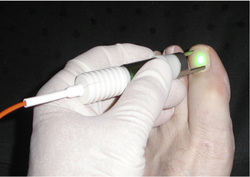
The laser used by San Francisco laser toenail housecalls is one of the newest medical lasers on the market. In fact it has is only been on the market for less than a year, at the time of this writing. Like most technologies, there are continual improvements with equipment and techniques. This newer laser is much more compact than older models allowing us to bring it on house calls.
The laser that we bring to your home or office in order to remove the toenail fungus and treat your toenail fungal infection is a multifunctional medical diode laser system. The laser is capable of radiating light in a number of wavelengths including 810 nm, 980 nm, and 1064 nm.
The 1064 nm wavelength is the wavelength that is currently considered to be the most effective at treating onychomcosis (fungal toenail infection)1,2. We use the new German-made A.R.C. Laser Medical Diode Laser System.
When we bring the A.R.C. Laser to your home or office the podiatrist will program the laser system to produce a laser beam in the 1064 nm wavelength.
The light spectrum can be divided by wavelength as follows:
Gamma ray: less than 0.01 nm
X-ray: 0.01 nm to 10 nm
Ultraviolet: 10 nm – 380 nm
Visible light: 380 nm – 700 nm
Infrared: 700 nm – 1 mm
Microwave: 1 mm – 1 meter
Radio: 1 mm – 100,000 km
The medical laser system we use to treat toenail fungus is 1064nm. Since 1064nm is greater than 700 nm and less than 1 mm, this means that the laser beam is categorized as an “infrared” beam of light energy.
The laser beam itself is invisible. When the treatment is being performed, you will see a small spot of light moving back and forth across the toenail. The light you see is not actually the laser. The light you see is simply an aiming light. Because the laser beam itself is invisible it’s necessary to have an aiming light that allows the doctor properly direct the laser beam in order to kill the fungus that’s within the toenail.
The laser can kill the fungus. But the laser can also damage your eyes. looking directly into the laser beam or from light reflected by the medical laser beam system could cause serious eye injury.
Even though the laser is invisible (unlike a laser pointer) you have to protect your eyes from damage. Both you (the toenail fungus patient) and the doctor performing the laser toenail fungus removal procedure will wear protective eyewear that will shield you from any possible harm. The doctor will bring and supply a pair of specially constructed glasses that protect your eyes during the laser toenail fungus treatment.
The protective glasses simply look much like green tinted sunglasses. You can still see just fine with the glasses on. Because the procedure takes about 20 minutes or so, most patients will work on a laptop computer or an iPad while they are having the laser toenail fungus removal procedure. The laser protection eyeglasses not interfere with these activities at all.
Dr. Christopher Segler is board certified, American Board of Podiatric Medicine. He believes that the best medicine is fast, convenient and low-cost. He sees patients all over the Bay Area in order to help them treat their toenail fungal infections with one of the newest lasers available.
We offer house calls all over the San Francisco area, including the Marina, Castro, Sunset, Richmond district, Cow Hollow, Presidio, Seacliff, Downtown, Nob Hill, Russian, and the Financial district. We will even see you at home in Mill Valley, San Rafael, San Bruno, Oakland or Berkeley.
If you have a question about toenail fungus and wonder whether or not the laser fungus removal treatment might be right for you, you can call and speak directly with a toenail expert by calling 415-308-0833. And yes, you will actually get to speak with the doctor.
References:
1. Mozena, John; Haverstock, Brent (May 2010). "Laser care for onychomycosis: can it be effective?". Podiatry Today 23 (5): 54–59.
2. Mozena, John D.; Mitnick, Joshua P. (October 2009). "Emerging concepts in treating onychomycosis". Podiatry Today 22 (10): 46–51.
 RSS Feed
RSS Feed